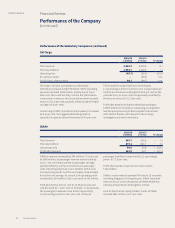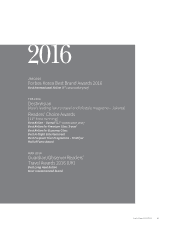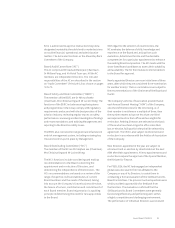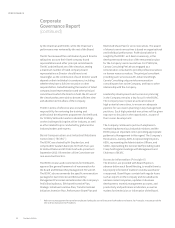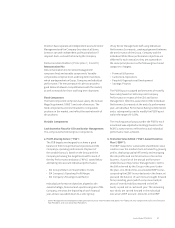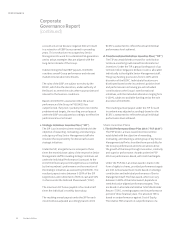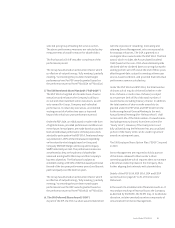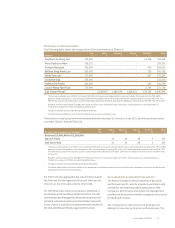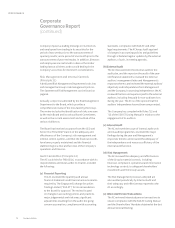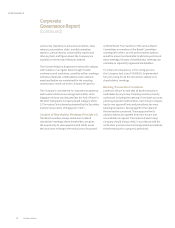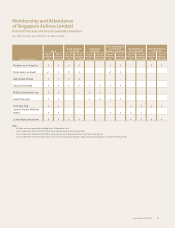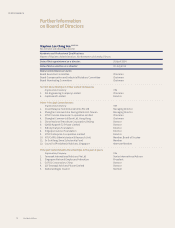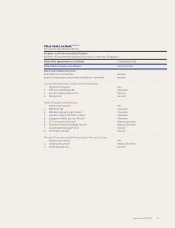Singapore Airlines 2016 Annual Report Download - page 69
Download and view the complete annual report
Please find page 69 of the 2016 Singapore Airlines annual report below. You can navigate through the pages in the report by either clicking on the pages listed below, or by using the keyword search tool below to find specific information within the annual report.Directors have separate and independent access to Senior
Management and the Company Secretary at all times.
Directors can seek independent professional advice if
required. Such costs will be borne by the Company.
Remuneration Matters (Principles 7, 8 and 9)
Remuneration Mix
SIA’s remuneration mix for Senior Management2
comprises fixed and variable components. Variable
components comprise short- and long-term incentives,
which are dependent on Group, Company and individual
performance. The remuneration mix aims to provide a
good balance between competitiveness with the market,
as well as rewards for short- and long-term objectives.
Fixed Component
The fixed component comprises base salary, the Annual
Wage Supplement (“AWS”) and cash allowances. The
fixed components are benchmarked to comparable
positions in the market, and reflect the market worth of
the positions.
Variable Components
Cash Incentive Plans for CEO and Senior Management
This comprises the following four components:
a. Profit-Sharing Bonus (“PSB”)
The PSB targets are designed to achieve a good
balance of both Group financial objectives and the
Company’s operating performance. Payment of
the variable bonus is based on the Group and the
Company achieving the target levels set for each of
the Key Performance Indicators (“KPIs”) stated below
and taking into account individual performance:
• SIAGroup’sReturnonShareholders’Funds
• SIACompany’sOperatingProfitMargin
• SIACompany’sPassengerLoadFactor
Individual performance objectives aligned to the
overall strategic, financial and operational goals of the
Company, are set at the beginning of each financial
year and are cascaded down to a select group
2 Senior Management are employees holding the rank of Senior Vice President and above. For FY2015/16, they comprised the CEO, two Executive
Vice Presidents and nine Senior Vice Presidents.
of key Senior Management sta using Individual
Performance Scorecards, creating alignment between
the performance of the Group, Company and the
individual. While these performance objectives are
dierent for each executive, they are assessed on
the same principles across the following four broad
categories of targets:
• Financial&Business
• Customer&Operations
• People&OrganisationalDevelopment
• StrategicProjects
The PSB Payout is capped at three times of monthly
base salary based on SIA Group and Company
Performance in respect of the CEO and Senior
Management. Aer the assessment of the Individual
Performance Scorecards at the end of a performance
year, an Individual Performance Rating is determined
and is subsequently used to modify the PSB Payout
within the range of 0-150%.
The resulting annual payout under the PSB for each
incumbent was adjusted accordingly based on the
BCIRC’s assessment to reflect the actual individual
performance level achieved.
b. Economic Value Added (“EVA”)-based Incentive
Plan (“EBIP”):
The EBIP rewards for sustainable shareholder value
creation over the medium term achieved by growing
profits, deploying capital eiciently and managing
the risk profile and risk time horizon of an airline
business. A portion of the annual performance-
related bonus of key Senior Management is tied to
the EVA achieved by the Group in the year. Under
the plan, one-third of the accumulated EBIP bonus,
comprising the EBIP bonus declared in the financial
year and the balance of such bonus brought forward
from preceding years (which comprises multiple
years of incentive dollars retained in the EVA
bank), is paid out in cash each year. The remaining
two-thirds are carried forward in the individual
executive’s EBIP account. Amounts in the EBIP
Annual Report FY2015/16 67



